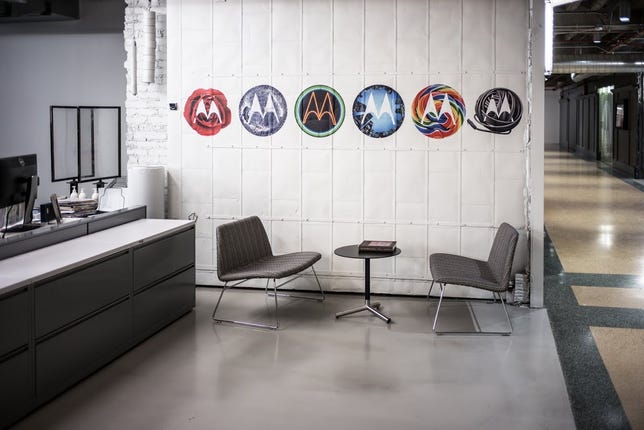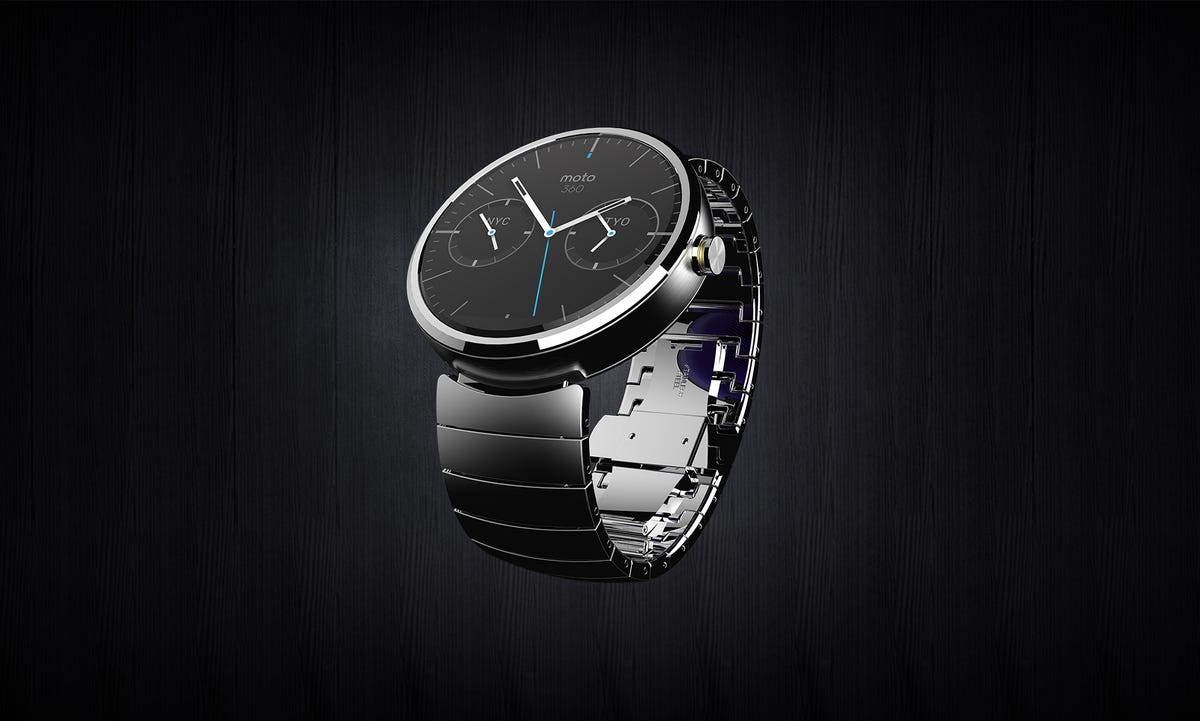
Motorola Mobility
It started with a chart on a wall.
Mark Randall, head of supply chain and operations for Motorola Mobility, was sitting in a meeting with a Brazilian carrier. The meetup was part of a world tour of carriers that he and then-CEO Dennis Woodside embarked on shortly after joining the company in 2012. Sitting in an office in Sao Paolo, Brazil, a poster on the wall caught Randall’s eye. It featured a graphic of every handset in the market arranged by cost, and he fixated on one corner.
“I looked at the value end of the chart, and I thought to myself, wow, this was terrible,” Randall said in an interview late last year. “If you’re a consumer who doesn’t want to spend $600 on a phone, you’re getting a raw deal.”


Motorola Mobility
That chart, which Randall asked for and received a copy of from the carrier, sparked a discussion with Woodside and key Motorola Mobility product executives including Charlie Tritschler. The result: Moto G , a smartphone that’s been praised for offering high-quality components at $179 unlocked, or without a contract.
While high-profile players such as Apple, Samsung Electronics, and HTC have staked their claim at the high end with premium smartphones that retail for around $650 without a contract, Motorola is taking a different route to reach consumers. Motorola Mobility, which is in the process of being sold by Google to China’s Lenovo, is making its big calls at the low end of the market and what it calls “the next billion customers” who can’t afford a smartphone — or even access the Internet.
While the market is flooded with cheap Android smartphones — just visit a local Chinese electronics store — Motorola stands out for phones that run the latest version of Android, use quality components, and offer a build quality that’s far better than its price suggests.
“We believe that a quality mobile experience is a right, not a privilege,” said Tritschler, who took over as senior vice president of product for Motorola after Rick Osterloh, who was promoted to president and chief operating officer.


Motorola Mobility
Motorola on Tuesday took another step toward lowering the cost for high-function smartphones with the Moto E, the third member of its Moto product family after the Moto X and Moto G. Part of the company’s strategy to get more affordable smartphones in more hands, the Moto E will retail for $129 without a contract. Comparable phones at that price often come with older versions of Android or lower quality components such as slower processors or cheaper glass.
Giving more people access to smartphones and the Internet is a very Google way of thinking (Google bought Motorola Mobility in May 2012 and announced the $2.9 billion sale to Lenovo in January). The strategy has resulted in at least one small victory: Tritschler boasted to CNET in early May that the Moto G, introduced in November, was already the company’s most successful smartphone in Brazil, and the Moto G has outsold both the Moto X and its Droid smartphones.
One popular smartphone, however, can’t revive the fortunes of a business that hasn’t seen a profit in more than three years. In the first quarter, Motorola saw its loss widen to nearly $200 million from a year earlier. The business, which invented the cellphone and was a dominant force in mobile in the 1980s, never really got a good hold in the smartphone business. In 2007, it had 6.1 percent of the global market and was the third-largest smartphone maker in the world, according to research firm IDC. By last year, it held 1.2 percent of the market and was ranked No. 15.
It’s Motorola’s still-weak position in the market that raises questions about how it will change once Lenovo takes control of the company. Lenovo is ranked fifth in the world among smartphone makers, but would hop to third with the addition of Motorola.
“Motorola is a reflection of what Google wanted it to be and what it needed to be,” said Jan Dawson, an analyst at Jackdaw Research. “It’s not an indication of what it will be under Lenovo.”
Shortly after Lenovo announced the acquisition from Google, CEO Yang Yuanqing called Motorola a . But the company hasn’t yet laid out how it would do so, and just what elements of Motorola will remain after the takeover.
Tritschler said Motorola is “manically focused” on continuing its strategy of driving down prices on quality smartphones.
Motorola’s new guard
When it comes to mass-producing a quality product at a low price, there are few executives as experienced as Randall. His last gig was at Amazon, where he dealt with the supply chain and the e-commerce company’s Lab126 unit — home to the Kindle Fire, a product that redefined pricing for tablets when it originally launched in November 2011 for $199 — well below the $499 price for a base model iPad.
His past stints include working for global phone maker Nokia, which at its peak in the mid-1990s to early 2000s dominated in emerging markets such as India and Brazil with affordable cellphones.


Motorola Mobility
Tritschler also joined from Amazon, where he led development of the Kindle product line. He joined Motorola in 2013, about a year after Randall.
Randall and Tritschler are part of the new guard at Motorola, joining after Google took control and named Woodside as CEO (Following the deal with Lenovo, Woodside left and now serves as chief operating officer of cloud-storage provider DropBox). Randall said he joined Motorola because of Google and its “willingness to make big bets.”
With those big bets came a new way of thinking. Motorola’s traditional mentality was to build flashy flagship phones — recall the StarTAC, the first-ever clamshell phone and the ultra-thin Razr flip phone. When Motorola CEO Sanjay Jha introduced the company’s first Android smartphone, the original Droid, in 2009, it was a splashy product launch that was backed by Google and Verizon Wireless, who spent $100 million promoting the original Droid.
That legacy continued into summer 2013, when Motorola released its Droid Ultra lineup as an exclusive to Verizon. A few weeks later, Motorola would introduce the more Google-influenced Moto X, which serves as its current high-end flagship phone.
But Randall and Tritschler were already working on something completely different. Randall talked up his Amazon experience with the development team, which was overseen by Tritschler, and challenged them to create a smartphone built with the same principles as the Kindle Fire: a quality device that didn’t compromise on specifications.
The typical development period for a phone was 12 to 18 months at Motorola. For the Moto G, Randall said his team reduced the time frame to just nine months.


Sarah Tew/CNET
“I really pushed hard for the supply team to design a product that had incredible specs,” he said.
After the whirlwind development effort, Woodside and Tritschler were on stage at an event in Brazil in November to unveil the Moto G. The reaction was positive. Tritschler said total unit sales in the first quarter grew 61 percent from a year ago, largely driven by the Moto G.
“What Motorola has done is present a phone at a certain price, but with a higher quality,” said Ramon Llamas, an analyst for IDC. “It’s a very smart process. Users are not ignorant of what a good smartphone is.”
Randall, meanwhile, said he did some “bureaucracy busting,” and slimmed down the organization and cleared up responsibilities for each element of the supply chain. He wasn’t the only one who sliced operations. Last year Google initiated massive layoffs, including the loss of 5,400 jobs in the second quarter alone out of a total of 7,200.
Lowering the barrier
While the Moto E unveiling comes six months after the Moto G, executives insist it was part of their game plan.
“Even while we were working on Moto G, we were thinking of Moto E,” Tritschler said.
Fortunately, many of the changes made to the manufacturing and supply chain process helped to speed the development of the Moto E. The company also made tweaks based on what didn’t work with the Moto G production process, although he declined to provide specific examples.
Related stories
- Hands-on with the Motorola Moto G LTE
- Lenovo will juggle two-brand strategy with Motorola
- Google sells Motorola unit to Lenovo for $2.9B
- Motorola losses widen ahead of sale to Lenovo
- Motorola: A love story
The Moto E has a 4.3-inch display and a slower dual-core Qualcomm chip, compared with the Moto G’s 4.5-inch screen and quad-core processor. It’s also missing a front-facing camera and the touchless controls that were a hallmark of the Moto X.
But the Moto E features the same all-day battery, sports a customizable back cover just like the Moto G, and offers the same rear camera and Gorilla Glass touchscreen display. It also shares the same design and feel as its higher-priced siblings.
The Moto E also has dual-SIM capabilities in certain markets such as India and Brazil, allowing customers who have multiple carrier accounts to switch between services to better take advantage of cheaper calling rates. Tritschler said Motorola is developing software that will detect the optimal time to use a specific SIM card based on the rate or the person.
Considering the price, the trade-offs seem fair.
At $129, the Moto E is only $50 cheaper than the Moto G. But looking at the demographic of customers Motorola is targeting, that $50 represents a huge difference, Tritschler said.
Under new management
Will all this progress stall once Lenovo steps in?
Not at first. Just as Motorola continued to carry on development of its product pipeline under Google, it will work through the additional products in its queue, such as a potential successor to the Moto X, as well as its upcoming Moto 360 smartwatch.


Motorola
But things becomes less clear over time. Motorola still runs at a loss, so Lenovo, which isn’t interested in running a money-losing business, will almost certainly make changes.
“What does Lenovo have to do to Motorola to knock it into shape?” Dawson asked.
The need to lower costs suggests that further job cuts are a possibility, and that the production may have to shift to Lenovo’s own facilities in China. The Moto X, for instance, is manufactured in Fort Worth, Texas.
Will Lenovo be as interested in creating wallet-friendly, but high-quality phones? Analysts say that strategy was Google’s way of taking control of the fragmented market for cheap Android smartphones in emerging countries. Lenovo, which ranks second in China behind Samsung, has its own experience in the low-end of the market, and its vision may not line up with Motorola’s executives.
It’s not unfathomable that Lenovo may eventually produce its own smartphones with a Motorola brand slapped on top, Dawson said.
Lenovo CEO Yang said back in January that he doesn’t see a need for layoffs and that he would keep Motorola’s newly built headquarters in Chicago. Lenovo executives haven’t been too keen to say anything else, including when the deal is expected to close.
But Motorola’s strategy of driving costs down in its phone is one of the reasons Lenovo was interested in the business, Tritschler argued.
Osterloh, speaking at a press conference at Mobile World Congress in February, said Lenovo is “committed to helping us deliver the products we’re working on now.”
And then?
“We’ll look at opportunities beyond that,” he said.



